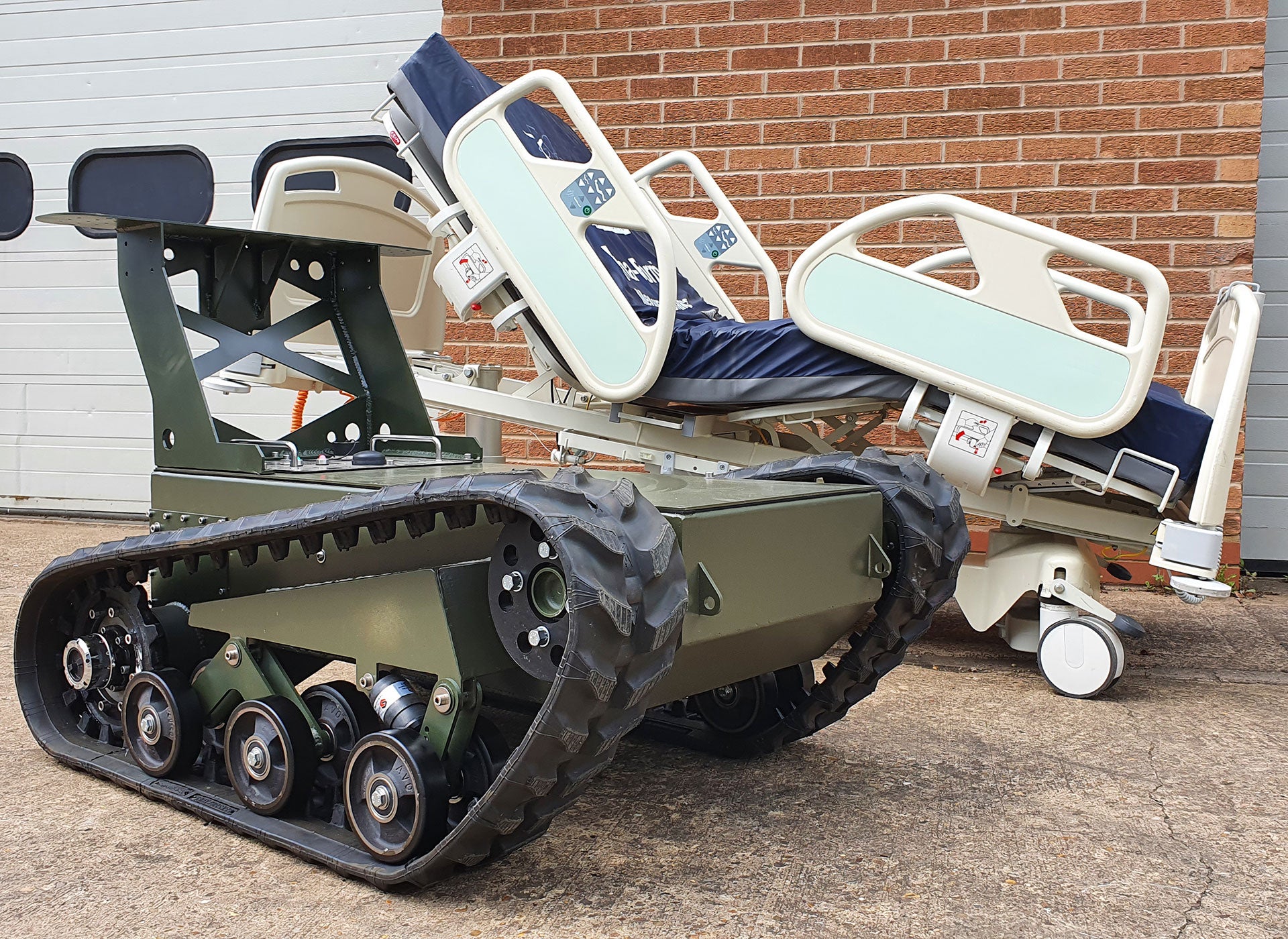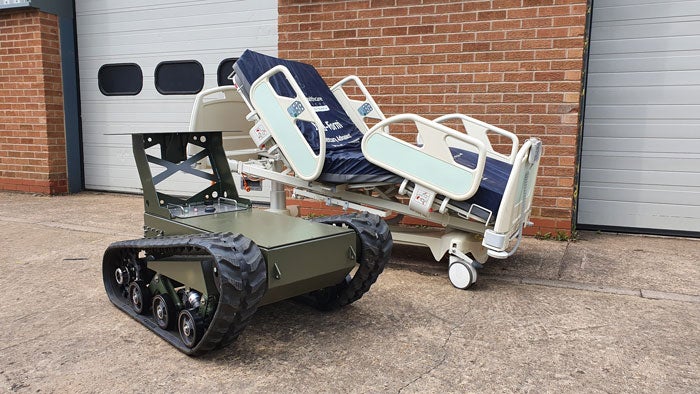 Image courtesy of Digital Concepts Engineering
Image courtesy of Digital Concepts Engineering
Digital Concepts Engineering (DCE) has used its experience in the military, agricultural and nuclear industries to repurpose its tech with the aim of responding to the Covid-19 coronavirus pandemic, and the result is self-driving hospital beds designed to safeguard medical staff, and social distancing sensors for unmanned vehicles.
In the early grips of the Covid-19 pandemic, hospital porters, the staff who move beds from one ward to another as well as a host of other jobs that keep hospitals moving, were hit particularly hard.
A number of porters died after contracting the virus when moving patients. In response to this DCE took on the challenge of looking at how the number of people needed to move a patient with a highly infectious disease could be decreased.
A solution for this came from an unlikely place, the company’s experience in robotics and unmanned ground vehicles or UGVs, usually used by the military and nuclear sectors.
This, combined with its wealth of experience in control systems, presented the opportunity to develop a system that can retrofit to a hospital bed to move by itself, around the building, following a nurse. This will cut the people needed to transport a patient by 50%, allowing porters to focus on other tasks.
Self-driving hospital beds: Helping porters to social distance
The challenge, which stemmed from Innovate UK, a UK government funding body, has resulted in ‘Helios’ a system that can rapidly attach to and detach from existing beds to give them a new lease of life and increase staff-safety.
This was developed based on the fact that NHS needs these capabilities to protect its people, it also needs these innovations delivered at a cost it can afford when health budgets are tight, and the services pushed to their limits. It cannot afford to buy a whole suite of new robotic hospital beds (even if they were available).
“There was an Innovate UK call that came out two months ago now in relation to Covid-19. The challenge that they threw down to industry and academia was ‘What can people develop at a relatively low cost that will help any industry, but in our particular instance, healthcare, respond to Covid-19?’,” Lionel Nierop, director at Digital Concept Engineering, tells Verdict.
“That particular week, we’d been hearing a lot about the number of hospital porters who had been exposed to Covid-19 and then had died. We spoke to a number of medics to really understand what they were looking at. One of the things that came out was that currently if you’re moving a hospital bed around the hospital, you typically have a hospital porter (who requires PPE when they move the bed) and you’d also have a nurse involved as well.
“Our question was ‘well, what happens if we take porter out of the loop? Can we actually cut the number of people that are required to handle a patient by 50%? Answer yes, we can.”
 DCE’s self-driving hospital beds.
DCE’s self-driving hospital beds.
Enabling beds to autonomously navigate hospitals
The solution here for DCE was to take existing components, of existing systems and put them together in a new in order to quickly and cheaply fill a highly complex technological need. To do so the project was broken down into two tracts, one to figure out how to retrofit robotics to a hospital bed, and two, to apply control systems knowledge and expertise to expand the functionality of the solution.
In order to allow the bed to navigate the corridors and wards of a hospital, and to follow a nurse around the building, the bed needs to be able to see its surroundings and know where the staff and other objects are, so it can navigate the area safely.
“What we can do here is apply some of the technology that we’ve developed for the military and nuclear space to this to build a robotic hospital bed. What we now have is a project in which we’ll be doing two things,” Nierop explains.
“First of all, we will be producing a system that will retrofit to any hospital bed which will allow the beds to be moved around by a small powered unit. We will also be applying some of our control system expertise and other stuff that we’ve been working on the robotic vehicles. It’ll allow beds to follow the nurse around the hospital so that the nurse can focus on giving the patient the care that they need.
“If the nurse is walking three meters in front of it, the bed will know where they are. We are taking that autonomy technology into the hospital space and presenting something entirely new. Some of the technology there will be relevant to the systems that we have developed for other sectors. As developments go on here, they will also feedback into the army and nuclear programs too.”
From robotic vehicles to social distancing sensors
Another challenge Covid-19 has thrown up has been the need to enforce social distancing, in order to help prevent the spread of the virus, especially in enclosed spaces such as shops, offices and factories.
A problem, however, is social distancing is hard to monitor via traditional means, and the current approach of signage can either be distracting or ignored. Anyone who has visited a supermarket since the start of lockdown will know this.
Again, like the self-driving hospital bed solution, DCE took its existing technology off the shelf and retooled it for a new purpose. In the case of social distancing, this meant not asking: “how do you keep two people away from each other”, but rather: “how do I know the distance between two points”.
This is a problem the company solved long ago when developing robotic systems, as vehicles need to know where they are relative to each other to operate safely.
“In this particular instance, going back to our generalizable toolkit approach, it was the recognition that for any sort of vehicle, you need some way of making sure that it avoids people in the battlefield or indeed any other space. We were working on solving that problem with a range of technology and we also realized that actually a vehicle could just as easily be a person,” Nierop explains.
“If you can detect where two people are relative to one another, you can then apply control systems stuff that we’ve got on the shelf and say, okay, you’re three metres away, you’re fine.
“Now you’re getting close, and now you’re definitely too close. What we have developed is a little wearable system that monitors your social distancing. It will buzz when you three meters away from someone, and then if you get within two meters it sounds an alarm to make sure that you know that you’ve got too close to that person.”
Providing space to focus
This is important as it allows people, especially in complex or dangerous jobs to focus on the task at hand, rather than what the person in the next bay is doing.
“Why is this important? Really, there are several things within this,” says Nierop.
“One is that a lot of people, a lot of companies are putting a huge amount of effort into redesigning their facilities, which is understandable.
“But often a lot of this is cosmetic. It is putting stickers on the floor, reminding people that they need to stay two meters away from one another. And approaches like that are fine. The big problem with them is that firstly, it’s really difficult to monitor to make sure that people are actually complying with them.
“And secondly, that is a huge amount of effort to focus on that and concentration.”
As businesses look to build their operations back to pre-lockdown levels, and economic activity increases, allowing staff to focus on their jobs means safety and productivity are improved. This inspired DCE’s approach to social distancing, which is to step in when there is a danger, rather than at every step along the way, potentially causing more problems.
Read more: Temperature screening robot to support reopening offices
Global Construction Outlook to 2024 (COVID-19 Impact)

Our parent business intelligence company